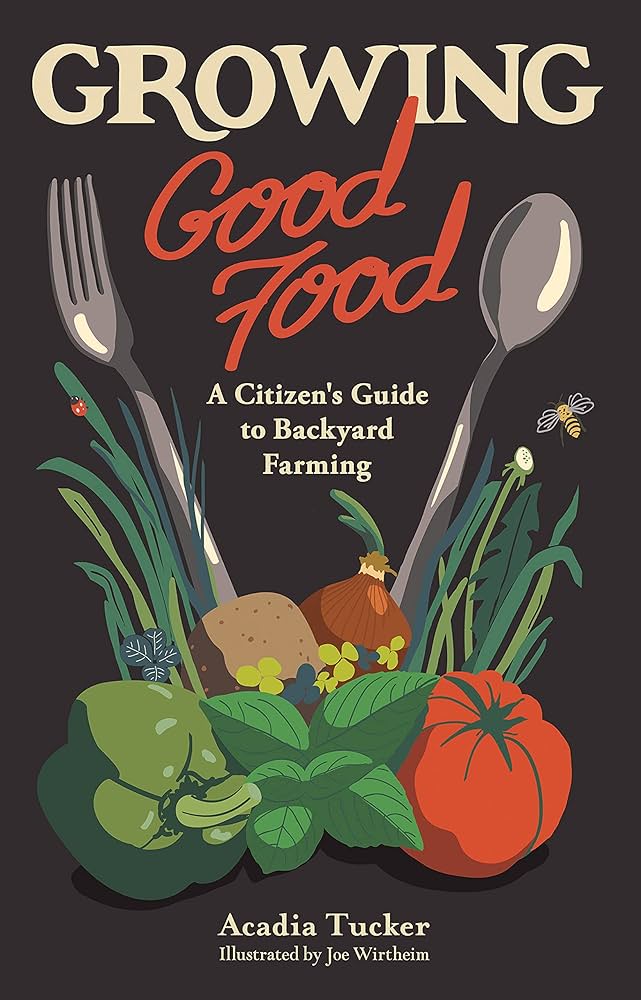[ad_1]
Title: Rising Good Meals, A Citizen’s Data To Yard Carbon Farming
Creator: Acadia Tucker
Author: Stone Pier Press
Promote your rototiller and ditch the factitious fertilizers. Plant an area climate victory yard and luxuriate in a bounty of meals with a lot much less work.
Yard carbon farming and regenerative practices sound like enormous ideas – and so they’re. Nonetheless creator and regenerative farmer Acadia Tucker wants every gardener to know that they’re actually pretty straightforward ideas. If every gardener embraced them and planted a native climate victory yard, we’d make a significant contribution to decreasing atmospheric carbon and slowing native climate change. Plus, everyone would eat an entire lot extra wholesome. The beauty of the thought is that the usual of the meals you develop is inextricably linked to bettering the native climate. And that’s a win/win for everybody.
Tucker has a novel perspective on the native climate catastrophe. Working as a farmer from Washington State to New Hampshire, she has seen radical, unpredicted shifts in native climate that decimated delicate annual crops nevertheless spared perennials. She has moreover seen the excellence it makes to those crops when soil includes an abundance of pure supplies vs traditionally farmed soil which doesn’t. It’s fascinating to be taught in regards to the strategies she and her companions employed to rehab an earlier plant nursery and the way in which some typical methods failed miserably. Experience is actually the perfect teacher.
What’s an area climate victory yard?
Think about the deep forest. Within the occasion you’ve ever hiked into deep woods you perceive how excellent it is – and that’s because of no folks interfered with the pure cycle of growth or further importantly, the soil. Years of carbon-rich supplies have fallen and decayed and are trapped there and might keep so for 1000’s of years, besides and until it’s deforested. Crops develop perpetually, making a rich ecosystem, undisturbed and unaided by human fingers.
The considered an area climate victory yard is “rooted” inside the deep forest occasion. Perennial meals crops return 12 months after 12 months – these with a woody development like fruit timber and raspberries retailer carbon, those that develop close to the underside like strawberries act as a groundcover. If gardeners develop principally perennial crops like blueberries, raspberries, blackberries, strawberries, fruit timber, asparagus, rhubarb, spinach, potatoes, garlic, kales, lettuces, a variety of herbs, and comparable crops, further carbon is perhaps saved inside the crops and the soil. Planting perennials signifies that soil stays comparatively undisturbed for years after planting, developing pure matter inside the soil, which feeds crops, outlets carbon, and manages water.
It is attainable you may not discover that every one the crops talked about above can actually be grown as perennials. Objects of potatoes could possibly be left inside the flooring after harvest, as can garlic cloves to develop the subsequent 12 months. Positive kinds of onions will return 12 months after 12 months. One spinach plant, kale or lettuce left to go to seed creates many crops the subsequent spring (merely ensure you plant an heirloom, not a hybrid choice). Even peppers could possibly be grown perennially if the plant is launched indoors over the winter in areas that receive frost.
Spherical half of the carbon launched into the setting yearly is absorbed by oceans, crops, and soil. Soil does lots of the heavy lifting, storing 4 events further carbon than crops. We interrupt this cycle by plowing it, stripping it of forests, spreading chemical substances on it, and leaving it bare, and this has horrible penalties. When soil degrades, the molecules that bind carbon break down, realeasing it once more into the air. Instead of absorbing carbon, depleted soil further contributes to worldwide warming.
Regenerative practices develop meals in a strategy that returns atmospheric carbon once more to the soil, a course of known as sequestration. And all of it begins with crops.Acadia Tucker, Rising Good Meals
In Rising Good Meals: A Citizen’s Data to Yard Carbon Farming, Tucker lays out the basic plan for developing an area climate victory yard that anyone can observe: mapping your website, the place the perfect spot in your property is to begin out your yard, developing raised beds, grooming your soil, sheet mulching, the basics of composting, the fitting technique to start crops indoors, which crops to develop, and way more.
By following Tucker’s advice, chances are you’ll contribute to carbon seize in your yard, irrespective of its measurement, and luxuriate in a bountiful feast of fruits, herbs, and greens yearly. The irony is, as quickly as your perennial crops are established, you’ll do a lot much less work than in the event you occur to grew annual crops that needed to get changed yearly and weeded and watered judiciously. That’s a reasonably complete lot from any viewpoint. As a lifelong gardener, I acquired right here to this conclusion years previously – I wasn’t fascinated in regards to the carbon seize, almost doing a lot much less in my yard (with age comes information).
Rising Good Meals moreover comprises calls to movement and insights from leaders inside the regenerative movement, along with David Montgomery, Gabe Brown, and Tim LaSalle. Rising Good Meals: A citizen’s data to yard carbon farming is a companion to Rising Perennial Meals: A self-discipline data to elevating resilient herbs, fruits, and greens, moreover written by Acadia Tucker.
[ad_2]
